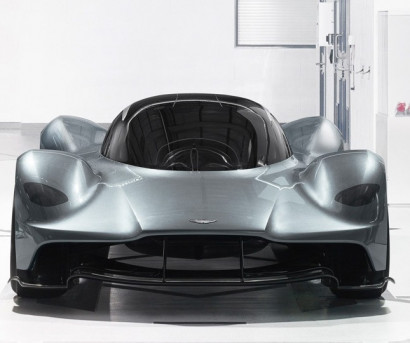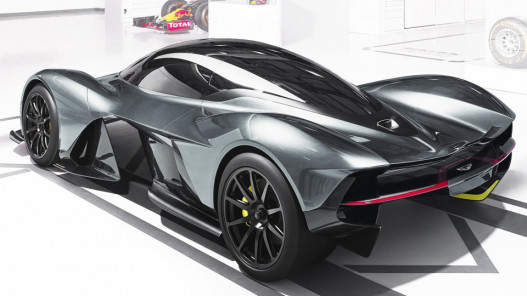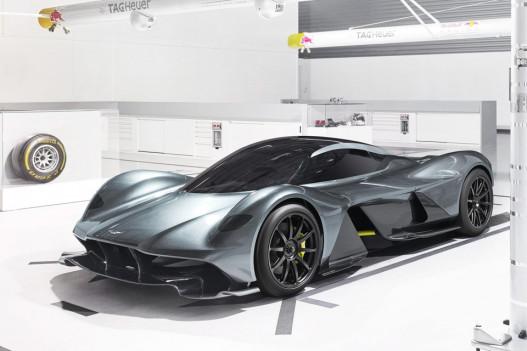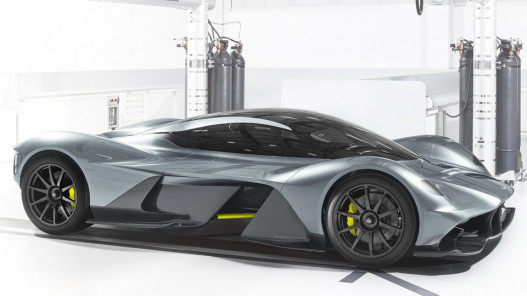How Aston Martin and Red Bull Racing Reinvented Car Design
 One thing unites all cars built for the road, from the dumpiest Chevy sedans to the most erotic exotics. In the eyes of a wind tunnel, they are all pigs. “What about the almighty sleekness of a Lamborghini or a Ferrari?” you might ask. To the wind tunnel they look like Conestoga wagons, or Spanish galleons, or equestrian statuary. We are talking air resistance here, or drag, caused both by automobiles’ size and irregular shape. Rub your eyes and look again. Bumpers, mirrors, wheels and tires, windshields the size of dining room tables. If the teardrop is nature’s most aero-efficient form, the automobile flies through the air like a kidney stone. And lift. Ugh. Again, as a wind tunnel sees things, a modern car looks like a wing: flat on the bottom and round on top. The faster you go, the more the wing wants to take flight. Meanwhile, in the few inches of ground clearance underneath the car, hurricane winds pile up to form a ragged zone of high pressure, lifting the car until the tires barely have any purchase. But what if road cars were shaped differently? What if, rather than becoming draggy and unstable with speed, family sedans became more stable, the invisible hand of the air pressing them to the tarmac rather than prying them loose? Formula One cars do this, and that ability in street-legal vehicles is the missing link between our current predicament and an alternate reality of high-speed mass transportation: silver rivers of cars pouring along expressways at unrestricted speeds. But even the best artificially intelligent autopilot can’t take us there until we fix the hardware, until auto makers teach road cars to stay on the road at 200-plus miles per hour. Adrian Newey, the chief technical officer for Red Bull Racing, gets paid a lot of money to see things as a wind tunnel sees them. He is the most accomplished race engineer in history, having won 10 F1 constructor’s championships with multiple teams over three decades. But Newey never worked on a road car before the one you see here, the AM-RB 001, a collaboration between Red Bull Racing and the British luxury-car maker Aston Martin. At the July unveiling in Gaydon, England, Aston Martin CEO Andy Palmer pulled the silk off a static model of the car, this lithe and improbable sculpture, suggesting a zero-altitude spaceship, or an animate flow of molten green lipstick. Behold a car that will attempt the previously unthinkable: to deliver racecar-rivaling performance in a drive-to-the-store passenger car with airbags and audio system. And with a fire-breathing V-12 too. Take that, Green Party. Only 175 copies of the 001 will be made, 150 street-legal and 25 track-only. Beginning in the first quarter of 2019, they will head out the door for the price of about $3 million each. Ordinarily, this is the sort of car I love to hate—a grand complication tourbillion of vanity, bought and sold by kings and kleptocrats as a way to keep score of their crimes. Newey feels my pain. “You could criticize this car as being for a wealthy or privileged few,” Newey says. “And that’s true. But you can equally say that art is pointless because art buyers are in the same category. For me it’s about learning from Aston Martin about road cars, so the technology that goes into this car can be reapplied in more mainstream vehicles.” The 001’s magic resides in the Newey-designed underbody. By virtue of its remarkable shape, the car generates not lift but what is called downforce—where the force of the air pins the car to the earth—and in unprecedented amounts. The unofficial figure of 4,000 pounds total downforce (track-only package) was whispered to me more in astonishment than confidence. Theoretically the 2,200-pound 001 could drive upside down across the roof of a tunnel, held up only by the force of the aero. Now, that’s stable. If the ideas embodied in here hold sway, future cars could all look very different, reborn in a design language that fundamentally alters the automobile’s historic relationship with the air. Actually stands it on its head. “This technology can be applied to all cars, absolutely,” Aston Martin chief designer Marek Reichman told me when we met. “Watch this space.” It seems hard to fathom, in the presence of the 001 model, that anything about it could translate to cars real earthlings drive; yet you don’t have to be an engineer to appreciate the aero-sleekness. “All fast things in nature are beautiful,” Reichman said, as we walked around the model together. In its way, the 001 points at a glaring absurdity of the world’s fastest cars. At top speed they are practically out of control. The Bugatti Veyron 16.4 Super Sport—world’s fastest production car—tops out at 268 mph. But the 1,200-horsepower, 4,052-pound car can hit that speed only on the virtually endless test track at Ehra-Lessien, VW’s facility in Germany. In order to hit that top speed, the Veyron must lower its stabilizing rear wing, assuming “zero downforce” posture to lower drag. In the words of Bugatti test driver Pierre-Henri Raphanel, the experience is “a little bit scary.” For the past 60 years, engineers and designers have battled the air with an arsenal of spoilers and rear wings—the kind you’ve seen in “Fast and Furious” movies. But big wings have their own problems. They trade downforce for added drag. So-called adaptive rear wings—rising and lowering on hydraulic struts—add weight and complication. And they look ridiculous parked in front of the club. The 001 doesn’t have a big wing hidden anywhere. The car’s upper half seems full of volition and art for art’s sake, untroubled by scoops, spoilers or technical surfaces. “Adrian and I hate big wings,” Reichman says. “Because the lower half of the car is doing all the mechanical work, the upper half offered more design freedom.” In racing, such downforce-generating forms are known as ground effects. As the name suggests, ground effects work better the closer a car is to the ground. That’s why race cars virtually skim the track. |




















